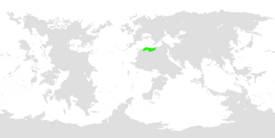Amil
People’s Republic of Amil Dʒumryad er-Amil Erṡevya 𐩳 𐩧 𐩺 𐩱𐩵 𐩧𐩽𐩱𐩣𐩡 𐩧𐩻𐩨𐩺𐩱 | |
|---|---|
| Motto: "Men Kebal Erṡwȧuv." ".𐩣𐩬 𐩤𐩨𐩱𐩡 𐩧𐩻𐩥𐩲𐩨" By the Peoples. | |
 Location of Amil in the world in light green. | |
| Capital | Fanesta |
| Largest city | Cirta |
| Official languages | Amiline (93%) Achysian (6%) Other (1%) |
| Ethnic groups (2019) | Amilians (86%) Achysians (12%) Muredans (1%) Other (1%) |
| Demonym(s) | Amilian Amiline Amilinian Hamyilic |
| Government | Federal Presidential Authoritarian Republic |
• President of the Amilian Reoublic | Sanusi Abul Tamali-er-Tamah |
| Legislature | Great Amilian Parliament |
| Great Amilian Senate | |
| Amilian House of Representatives | |
| Establishment | |
• as the Emkenate of Western Hamyil | Between 806 and 834 |
• as the Talemkenid Kingdom of Milil and the Talemkenid Kingdom of Hamyil | 1073 and 1122 |
• as the Talemkenid Kingdom of Milil, the Ȧpricanid Kingdom of Kartu and the Livyanid Kingdom of Libdi | 1073 and 1394 |
• as part of the Achysian rule and sphere of influence | from 1723 to 1753 |
• as part the Amilian kingdoms | 1800 and 1809 |
• as the Kingdom of Fanesta | 1898 |
• as the Kingdom of Amilia | 1912 |
• as the Republic of Amilia | 1947 |
• as the People's Republic of Amil (current form) | 1979 |
| Area | |
• Total | 739,130.44 km2 (285,379.86 sq mi) |
• Water (%) | IDK that also |
| Population | |
• 2019 estimate | 52,153,778 |
• Density | 70.56/km2 (182.7/sq mi) |
| GDP (PPP) | 2019 estimate |
• Total | Imma do it later |
• Per capita | 26,493.25 |
| GDP (nominal) | 2019 estimate |
• Total | later |
• Per capita | later too |
| Gini (2019) | low |
| HDI (2019) | high |
| Currency | Amilian Tinal (TNL) |
| Time zone | UTClater (later) |
| Date format | dd/mm/yyyy |
| Driving side | right |
| Calling code | +69 |
| Internet TLD | .hm |
Amil (Traditional Amiline: 𐩧𐩽𐩱𐩣𐩡 , formally known as the People’s Republic of Amil (Traditional Amiline: 𐩳 𐩧 𐩺 𐩱𐩵 𐩧𐩽𐩱𐩣𐩡 𐩧𐩻𐩨𐩺𐩱, also know as Amilia or Hamyil, is a country in the Hamyilic region of North Dihara. The capital is Fanesta and the most populous city is Cirta, both located in the far north of the country, in the Citra province, on the Elyrian coast. Amil dispose of an area of 739,130.44 square kilometres (285.38 sq mi) and an estimated population of over 52 million. Amil is hostorically and culturally very connected to Achysia, mostly by the Provinces of Tunas and Trebolis, who were under Achysian control, economically or militarily many times during history.
Name
The Name of Amil comes from the Old Amiline er-Hamyil, meaning litterally Amil. Hamyil comes from an unknown precise origin, but it's theorized that it could come from the very old Hamyilic divinity of land and agricultue, Xȧmyel (pronounced /xɒmje̞l/ in Amiline), or from the Old Elyrian word for fertile, IDR the word.
History
Prehistory and Ancient History
The eldest traces of a civilization on the Hamyilic coasts go back to -200,000, in the Cirta region. The first traces of agriculture goes back to -105,000, again, in the Cirta region, as it is, and was, the most fertile region of the coast. The first traces of Architecture, them, goes back to -10,000, and are identified as part of the Culture of Muridh, replaced around -7,000 by the Lotho Culture, and then, in -5,000 by the Hamyilic culture. The Hamyilians were known to be the first of the local peoples to tame the Mareavs (Dwarf Proboscideans). Writing came in Hamyil around -2,000, the Hamyilian elites, seeing other cultures using writing systems, decided to create their own.
Antiquity
The City-State of Milil emerged around the -900, quickly expanding to the next City-States, forming the Kingdom of Milil around -800. Then, around -700, vainquishing the City-State of Awʒd, and Awʒd's allied tribes, doubling their territory's size.
Middle-Ages
Text
Renaissance
Text
Light Ages
Text
Industrial Revolution
Text
Modern days
Text
Geography
Text
Landscape and Climate
Text
Administrative Divisions
Text
Politics
Text
Foreign Relations
Text
Demographics
Text
Population
Text
Ethnicity
Text
Language
Text
Religion
Text
Welfare
Text
Education
Text
Economy
Text
Transportation, Infrastructure and Energy
Text
Science and Technology
Text
Tourism
Text
Culture
Text
Architecture
Text
Art
Text
Cuisine
Text
Film
Text
Literature
Text
Media
Text
Music
Text
Philosophy
Text
Public Holidays and Festivals
Text
Society
Text
Sports
Text
Theater
Text

